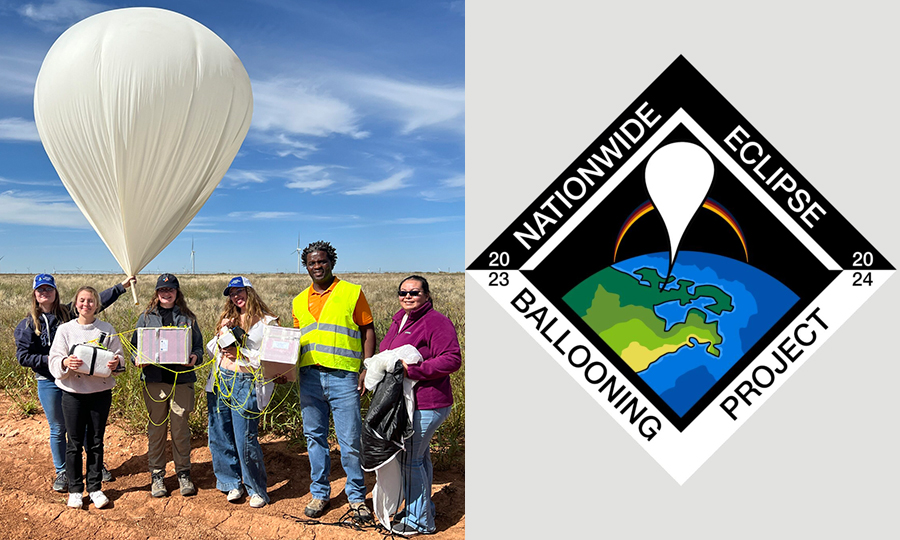Calendar Icon
Apr 04, 2024
Person Bust Icon
By Karl Vogel
![]() RSS
Submit a Story
RSS
Submit a Story

RELATED LINKS
The total eclipse that will be visible across a large swath of North America on Monday, April 8 is the last of its kind on this continent until 2044.
A team of Nebraska students will travel to southern Illinois and southeastern Missouri to witness the “totality” of the eclipse – when the moon’s orbit causes it to briefly (in this instance about eight minutes) blot out the sun. More importantly for the team, it’s a rare opportunity for valuable research.
They are among 53 engineering teams participating in the Nationwide Eclipse Ballooning Project (NEBP), whose aim is to immerse teams from higher education institutions “in an innovative NASA-mission-like adventure in data acquisition and analysis through scientific ballooning.”
Around 1:30 p.m. CDT near Perryville, Missouri the team will launch three HABs that will carry experimental payloads into the lower reaches of space. Those payloads, including scientific sensors, cameras and solar panels, will measure conditions that more closely replicate the lack of light in outer space, and atmospheric changes caused by the eclipse.
“What’s exciting about this mission is that beyond the instruments, measurements and the live streaming NASA is requiring, we will have two balloons on which students are going to be doing some testing during the eclipse,” said Karen Stelling, faculty advisor for UNL’s Aerospace eXperimental Payloads (AXP) team.
This is the second eclipse in the span of about six months for the Nebraska team, which also includes students and advisors from Metro Community College (the project lead) and the University of Nebraska Omaha with support from a NASA Nebraska Space Grant.
In October 2023, 14 members of the team traveled to Roswell, New Mexico to launch high-altitude balloons (HABs) during the annular eclipse, which is similar to the April 8 total eclipse, except that the edge of the sun remains visible as a bright ring around the moon.
In addition to performing tests with their payloads, the team saw the Roswell trip as a chance to work out any kinks in their processes before this total eclipse launch.
Each balloon will be equipped with a homing device so the Nebraska team can track its flight path and descent back to earth after the balloon deflates somewhere around 100,000 feet of altitude. The tracking team will be headquartered atop the Southern Illinois University (SIU) Physics building in Carbondale, Illinois.
SIU’s forestry students are supporting the Nebraska team and are prepared for almost any payload recovery scenario as they race to retrieve the balloons and payloads – including packing tree-climbing gear, ropes, kayaks and bicycles.
With thousands of people expected to flock to the area to view the eclipse, the retrieval process could be more difficult.
“We expect the area will be swamped with people to watch the eclipse, and we’ll have to navigate that as we try to chase down our balloons,” Stelling said. “That’s another challenge we face, which may include approval to access private property, climbing trees and crossing streams.”
The experience of being part of these two eclipse projects has extra benefits, the Nebraska Engineering students said.
“I really want to work in the aerospace sector after I graduate, and I realize that’s a lofty goal,” said Vince Orsi, a sophomore majoring in mechanical engineering. “This experience and being part of AXP can really open up massive pathways and help me get in.”
“Being part of the team is really nice to see what other engineering majors are doing and being able to use my knowledge,” said Nick Wayman, a sophomore in chemical engineering. “I believe I’m the only chemical engineer on this team, and I think that will be helpful in my career when I have that experience collaborating with engineers from other areas.”
The NEBP also opened up an opportunity for another Nebraska engineering student to be a part of each of the projects that launch on Monday.
Isaac Cade, a senior majoring in mechanical engineering, submitted the winning design in the national NEBP logo contest in the spring of 2023.
“It’s kind of a hobby,” Cade said about designing logos. “I like to doodle and get on my iPad and make random designs. My dad is on a bowling team, and I designed all the patches for his league. Then I saw the prompt for the NEBP and thought I’d give it a try.”
Cade’s design is a diamond-shaped logo depicting a white HAB lifting off from the earth against a backdrop of the halo of a sun partially obscured by the moon passing in front of it.
“I wanted to show that it was lifting up, moving into space, like our balloon is going to hopefully do during the eclipse,” Cade said. “I’m not much of a builder, I’m more of a design engineer, so it’s great to feel I can connect what I have done to what the rest of the team is doing and help to give people a better understanding of what the purpose of an engineer is.”
Submit a Story